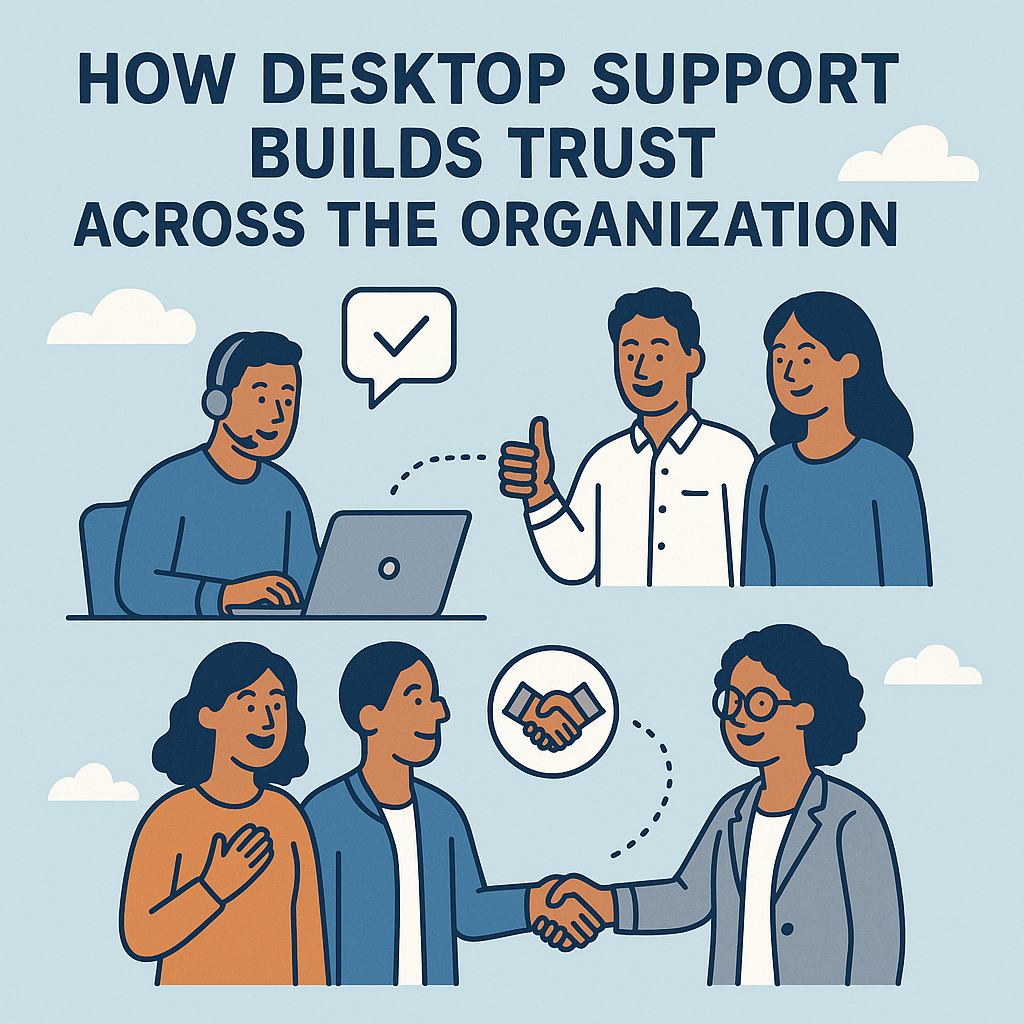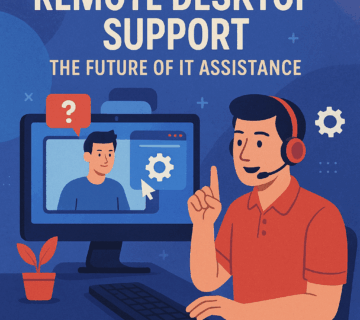The Future of Desktop Support in a Hybrid Work World
Introduction: Transforming IT Support for the Modern Workplace
The workplace revolution has fundamentally altered how organizations approach desktop support. As companies navigate the complexities of hybrid work environments, traditional IT support models are evolving at breakneck speed. This transformation isn’t just about fixing computers anymore—it’s about enabling seamless productivity across multiple locations, devices, and work scenarios.
Modern desktop support teams face unprecedented challenges. Employees switch between home offices, corporate headquarters, co-working spaces, and coffee shops, each presenting unique technical requirements. This shift demands a complete rethinking of support strategies, tools, and methodologies.
Understanding the Hybrid Work Challenge
Distributed Device Management
Managing technology assets across dispersed locations creates complexity that traditional centralized IT departments weren’t designed to handle. Employees now rely on personal devices, home networks, and varied software configurations that extend far beyond corporate control.
Support teams must adapt to troubleshooting issues remotely without physical access to devices. This reality requires new diagnostic approaches, enhanced remote access capabilities, and innovative problem-solving techniques that work across diverse technical environments.
Security Considerations in Hybrid Environments
Hybrid work introduces security vulnerabilities that desktop support teams must address proactively. Home networks lack enterprise-grade security measures, making corporate data more susceptible to breaches. Support personnel need training in security protocols that extend beyond traditional corporate boundaries.
The challenge extends to ensuring consistent security updates, patch management, and compliance monitoring across devices that may rarely connect to corporate networks. This requires sophisticated endpoint management solutions and clear security policies.
Emerging Technologies Reshaping Desktop Support
Cloud-Based Support Platforms
Cloud technology has become the backbone of modern desktop support operations. These platforms enable support teams to access, diagnose, and resolve issues regardless of device location. Cloud-based ticketing systems, knowledge bases, and collaboration tools ensure consistent service delivery across hybrid environments.
Advanced cloud platforms integrate artificial intelligence to predict potential issues before they impact productivity. This proactive approach reduces downtime and improves user satisfaction while optimizing support resource allocation.
Artificial Intelligence and Automation
AI-powered support tools are revolutionizing how desktop support operates. Intelligent chatbots handle routine inquiries, freeing human technicians to focus on complex problems requiring creative solutions. Machine learning algorithms analyze support patterns to identify recurring issues and suggest preventive measures.
Automated diagnostics can resolve many common problems without human intervention. These systems perform routine maintenance, update software, and fix configuration issues while users sleep, creating a more seamless computing experience.
Remote Monitoring and Management Solutions
Comprehensive monitoring tools provide real-time insights into device performance, security status, and potential issues. These solutions enable support teams to address problems before users notice them, transforming reactive support into proactive maintenance.
Advanced monitoring platforms track everything from hardware health to application performance, creating detailed analytics that inform support strategies and resource planning.
Strategic Approaches to Modern Desktop Support
Self-Service Support Portals
Empowering users with self-service capabilities reduces support ticket volume while improving resolution times. Modern portals feature interactive troubleshooting guides, video tutorials, and automated diagnostic tools that help users resolve common desktop support problems and solutions independently.
These platforms must be intuitive and accessible across various devices and technical skill levels. Successful self-service portals include comprehensive search functionality, step-by-step guidance, and seamless escalation to human support when needed. Desktop support software tools integrated into these portals enable automated diagnostics and real-time assistance.
Tiered Support Models
Implementing structured support tiers ensures efficient resource utilization while maintaining service quality. Level 1 desktop support handles routine inquiries and basic troubleshooting, while specialized technicians address complex technical challenges and system integration issues.
This approach allows organizations to scale support operations cost-effectively while ensuring users receive appropriate expertise for their specific needs. Clear escalation procedures prevent issues from falling through organizational cracks. Many companies are now exploring remote desktop support outsourcing to access specialized expertise without maintaining large internal teams.
Mobile-First Support Design
Desktop support now encompasses mobile devices as primary work tools. Support strategies must accommodate smartphones, tablets, and hybrid devices that employees use for professional tasks. This requires specialized knowledge of mobile operating systems, cloud synchronization, and cross-platform compatibility.
Mobile device management becomes crucial for maintaining security and functionality across diverse hardware configurations. Support teams need tools and expertise to manage everything from app deployment to data synchronization.
Measuring Success in Hybrid Desktop Support
Key Performance Indicators
Tracking meaningful metrics helps organizations evaluate support effectiveness and identify improvement opportunities. Response times, resolution rates, and user satisfaction scores provide quantifiable measures of support quality.
Advanced metrics include first-call resolution rates, preventive maintenance success, and cost per incident. These indicators help organizations optimize support operations and demonstrate value to business stakeholders.
User Experience Metrics
User satisfaction extends beyond technical problem resolution to encompass overall support experience. Measuring communication quality, support accessibility, and outcome satisfaction provides insights into service effectiveness from the user perspective.
Regular feedback collection through surveys, interviews, and usage analytics helps support teams understand user needs and adapt services accordingly. This user-centric approach drives continuous improvement and innovation.
Challenges and Solutions in Hybrid Support
Communication Barriers
Remote support requires enhanced communication skills and tools. Technicians must clearly explain technical concepts without visual cues, requiring improved verbal communication and documentation abilities. Video conferencing, screen sharing, and collaborative tools become essential for effective problem resolution.
Language barriers, time zone differences, and varying technical literacy levels complicate remote support interactions. Training programs must address these challenges while building cultural competence among support staff.
Resource Allocation and Scaling
Hybrid environments create unpredictable support demands that traditional staffing models struggle to accommodate. Organizations need flexible resource allocation strategies that can adapt to changing workload patterns and geographical distribution. Many businesses are turning to a remote desktop support outsourcing company to access 24/7 remote desktop support outsourcing services that provide round-the-clock coverage.
Cloud-based support platforms enable dynamic scaling, allowing organizations to adjust support capacity based on real-time demand. This flexibility reduces costs while maintaining service quality during peak periods. Desktop support for businesses increasingly relies on hybrid models combining internal teams with outsourced remote desktop support services.
Technology Integration Challenges
Hybrid work environments often involve multiple technology platforms that must work together seamlessly. Support teams need expertise across diverse systems, applications, and integration points that may not have been designed to work together. Understanding how to outsource remote desktop support effectively requires careful evaluation of vendor capabilities and integration requirements.
Standardization efforts help reduce complexity, but support teams must still navigate legacy systems, third-party applications, and custom integrations that create unique desktop support issues. Desktop support outsourcing can provide access to specialized expertise for complex integration challenges.
Future Trends and Innovations
Predictive Analytics
Advanced analytics platforms will increasingly predict support needs before issues occur. By analyzing usage patterns, performance metrics, and historical data, these systems can identify potential problems and trigger preventive measures automatically.
This proactive approach reduces downtime, improves user satisfaction, and optimizes support resource allocation. Organizations investing in predictive analytics gain competitive advantages through improved operational efficiency.
Augmented Reality Support
Emerging AR technologies will enable support technicians to guide users through complex procedures using visual overlays and interactive instructions. This technology bridges the gap between remote support and hands-on assistance, improving resolution effectiveness.
AR-powered support tools will become particularly valuable for hardware troubleshooting, network configuration, and complex software installations that benefit from visual guidance.
Blockchain for IT Asset Management
Blockchain technology offers potential solutions for secure, decentralized IT asset tracking and management. This technology could revolutionize how organizations track devices, licenses, and compliance across distributed hybrid environments.
Smart contracts could automate support processes, license management, and security compliance, reducing administrative overhead while improving accuracy and transparency.
Building Future-Ready Support Teams
Skill Development Requirements
Modern desktop support professionals need diverse technical skills that extend beyond traditional PC troubleshooting. Cloud platform expertise, mobile device management, and cybersecurity knowledge become essential competencies. Obtaining desktop support certification validates these expanded skill sets and demonstrates professional competence to employers.
Soft skills including communication, problem-solving, and customer service remain crucial as support interactions become more complex and relationship-focused. Training programs must balance technical and interpersonal skill development to prepare professionals for the evolving landscape of hybrid work support.
Career Evolution Pathways
Desktop support roles are evolving into specialized positions requiring advanced expertise in specific technology areas. Career paths now include cloud architecture, cybersecurity specialization, and user experience design roles that didn’t exist in traditional IT support.
Organizations must create clear advancement opportunities that recognize the increasing complexity and value of modern support roles. This includes compensation structures that reflect expanded skill requirements and responsibilities.
Cultural Adaptation
Support teams must develop cultural competence to work effectively across diverse, distributed teams. This includes understanding different work styles, communication preferences, and technical environments that vary by location and demographic.
Building inclusive support cultures that accommodate diverse user needs while maintaining consistent service quality becomes a competitive differentiator for organizations embracing hybrid work models.
Frequently Asked Questions
What are the biggest challenges facing desktop support in hybrid work environments?
The primary challenges include managing devices across multiple locations, maintaining security in distributed environments, providing effective remote troubleshooting, and adapting to diverse user needs across different work settings. Support teams must also handle increased complexity in device management while ensuring consistent service quality.
How can organizations prepare their IT support teams for hybrid work scenarios?
Organizations should invest in cloud-based support platforms, provide comprehensive remote support training, develop clear communication protocols, and implement self-service tools. Teams need training in new technologies, enhanced communication skills, and security protocols specific to hybrid environments.
What technologies are most important for modern desktop support?
Essential technologies include cloud-based management platforms, remote access tools, AI-powered diagnostic systems, comprehensive monitoring solutions, and mobile device management platforms. These tools enable effective support delivery across distributed hybrid work environments.
How do security requirements change in hybrid desktop support?
Security becomes more complex as corporate data extends beyond traditional network boundaries. Support teams must implement endpoint security solutions, ensure consistent patch management, monitor home network connections, and maintain compliance across diverse environments while educating users about security best practices.
What metrics should organizations use to measure hybrid desktop support success?
Key metrics include response and resolution times, first-call resolution rates, user satisfaction scores, security incident frequency, and cost per support incident. Organizations should also track self-service portal usage, preventive maintenance effectiveness, and support team productivity across different support channels.
How will artificial intelligence change desktop support roles?
AI will automate routine tasks, enable predictive maintenance, and provide intelligent diagnostic assistance. This shifts support roles toward more complex problem-solving, strategic planning, and user relationship management. Support professionals will need to develop skills in AI tool management and interpretation of automated insights.
What are the cost implications of hybrid desktop support models?
While initial investments in new technologies and training may be significant, hybrid support models often reduce long-term costs through improved efficiency, reduced travel requirements, and better resource utilization. Organizations may see savings in real estate and traditional support infrastructure while investing more in cloud-based solutions and remote support tools.
How can small businesses implement effective hybrid desktop support?
Small businesses should focus on cloud-based solutions that scale with their needs, implement comprehensive self-service portals, partner with managed service providers for specialized expertise, and prioritize user training to reduce support demands. Cost-effective solutions include utilizing existing cloud platforms and focusing on preventive maintenance strategies.





No comment